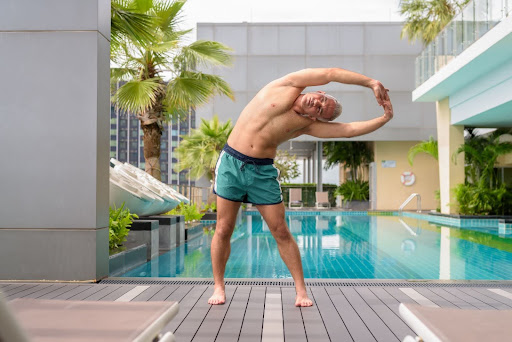
The recovery paradigm is an evolving approach that goes beyond the physical aspects of wellness, focusing on empowering individuals to reclaim their lives and thrive despite challenges.
Rooted in mental health and addiction recovery, this paradigm advocates for holistic healing that encompasses the mind, body, and spirit. As a Fitness & Recovery Advisor, I believe this model is key to achieving sustained energy, peak performance, and lasting well-being in any fitness journey.
In this article, we will explore how the recovery paradigm can be applied to fitness and overall wellness, fostering resilience, self-empowerment, and the long-term benefits of balanced physical and mental health.
What Is the Recovery Paradigm in Fitness?
The recovery paradigm in fitness draws inspiration from the principles developed in mental health and addiction recovery. Traditionally, recovery was viewed as simply managing symptoms or taking breaks.
However, the recovery paradigm redefines it as a lifelong journey of empowerment, transformation, and fulfillment. This approach doesn’t just focus on overcoming physical setbacks but promotes holistic well-being, addressing emotional, psychological, and social aspects of a person’s life.
Key aspects of the recovery paradigm include:
- Person-Centered Approach: Every individual’s fitness journey is unique, and recovery is driven by personal goals, strengths, and needs.
- Hope and Optimism: Believing in a better, healthier future is vital for sustained progress.
- Empowerment: Helping individuals take control of their fitness and health decisions.
- Holistic Wellness: Recovery encompasses all aspects of life, including physical health, emotional well-being, and social connections.
- Strengths-Based: Focusing on an individual’s talents, resilience, and abilities, rather than their limitations.
How Does the Recovery Paradigm Apply to Fitness?
In fitness, recovery is often thought of as taking time off after intense workouts. While this is certainly important, the recovery paradigm goes beyond rest. It encourages individuals to approach recovery in a more comprehensive, integrated way.
Whether you’re dealing with a specific injury, facing emotional fatigue, or striving for long-term wellness, recovery should be seen as part of an ongoing process.
1. Physical Recovery

Physical recovery in the fitness context often includes rest, hydration, and proper nutrition. However, the recovery paradigm highlights the importance of active recovery, which involves low-impact activities such as walking, swimming, or yoga.
These activities promote blood circulation and aid in muscle repair without overstraining the body. By focusing on muscle regeneration and reducing inflammation, active recovery ensures that your body is fully prepared for the next challenge.
2. Mental and Emotional Resilience

Mental and emotional well-being are key to the recovery paradigm. In the fitness world, this means understanding the psychological aspects of training—how our emotions, stress levels, and motivation influence our ability to recover.
Techniques such as mindfulness, meditation, and breathing exercises are essential for reducing anxiety, enhancing focus, and improving emotional regulation. By practicing these techniques, individuals can achieve mental clarity, reduce stress, and increase self-awareness.
3. Community and Peer Support
Just as the recovery paradigm emphasizes the role of peer support in addiction recovery, in fitness, building a supportive network of like-minded individuals can help maintain motivation and accountability.

Whether through fitness communities, support groups, or training partners, social connections play a significant role in a person’s ability to recover and stay consistent. Group exercises or fitness challenges foster social well-being and help individuals share their journey and accomplishments, providing emotional support and encouragement.
Benefits of the Recovery Paradigm in Fitness and Wellness
Adopting the recovery paradigm in your fitness journey brings numerous long-term benefits:
- Sustained Energy: When recovery is approached holistically, individuals feel more energized and motivated for daily tasks and future workouts.
- Injury Prevention: A balanced recovery plan helps avoid burnout, overuse injuries, and physical setbacks that can derail your fitness goals.
- Improved Mental Clarity: Recovery strategies support emotional resilience and mental focus, crucial for high performance in workouts and life.
- Long-Term Wellness: By addressing the body, mind, and social aspects of recovery, individuals can experience greater overall well-being and avoid the negative effects of overtraining.
Implementing the Recovery Paradigm in Your Fitness Routine
To incorporate the recovery paradigm into your fitness routine, it’s essential to focus on a well-rounded approach to recovery that supports all areas of your life.
1. Prioritize Sleep
Quality sleep is foundational to recovery. Aim for 7-9 hours of sleep each night to allow your body to heal, recharge, and perform at its best. Establish a bedtime routine that promotes restfulness, such as avoiding screens or engaging in relaxation techniques before bed.

2. Fuel Your Body Properly
Recovery is also about proper nutrition. Focus on balanced meals that provide the right amounts of proteins, carbohydrates, and healthy fats. Post-workout meals should emphasize protein to help repair muscle tissue and complex carbs to replenish energy stores.

3. Incorporate Active Recovery
On rest days, engage in low-intensity activities like stretching, swimming, or yoga. These exercises promote flexibility, improve blood flow, and help the body recover without causing additional strain.

4. Mental Health and Stress Management
Incorporate mental recovery techniques such as mindfulness, journaling, or practicing gratitude. By managing stress and maintaining a positive mindset, you ensure that your emotional health aligns with your physical recovery process.

Also Read : 10 Things People Do to Stay Lean Year-Round (7 Will Surprise You)
Frequently Asked Questions (FAQs)
1. How do I know when to rest and when to push myself in my fitness routine?
Listen to your body. If you’re feeling fatigued, sore, or mentally drained, it’s time to rest. A good rule of thumb is to alternate between intense workouts and recovery days to avoid overtraining.
2. Can emotional well-being affect my physical recovery?
Yes, emotional well-being plays a significant role in physical recovery. High stress levels or negative emotions can delay recovery, while practicing mindfulness and reducing stress enhances the body’s ability to heal and perform.
3. What are the best activities for active recovery?
Low-impact activities like walking, swimming, cycling, or yoga are great for active recovery. These exercises help improve circulation, reduce stiffness, and keep your muscles engaged without overexertion.
4. How long should I focus on recovery between workouts?
The length of recovery depends on the intensity of your workouts. For intense sessions, aim for 24-48 hours of rest or active recovery. For lighter workouts, you may only need a shorter recovery period.
Embrace the Recovery Paradigm for Lasting Wellness
The recovery paradigm offers a transformative approach to fitness and wellness, encouraging individuals to see recovery not as a break from physical activity but as an essential part of their ongoing journey. By adopting a holistic mindset that includes proper rest, mental resilience, social support, and active recovery, you’re setting yourself up for long-term success.
Remember, the goal is not just to push through workouts but to foster overall well-being. Prioritizing recovery helps you achieve sustained energy, prevent injuries, and stay mentally focused, ensuring that you perform at your best for years to come.


